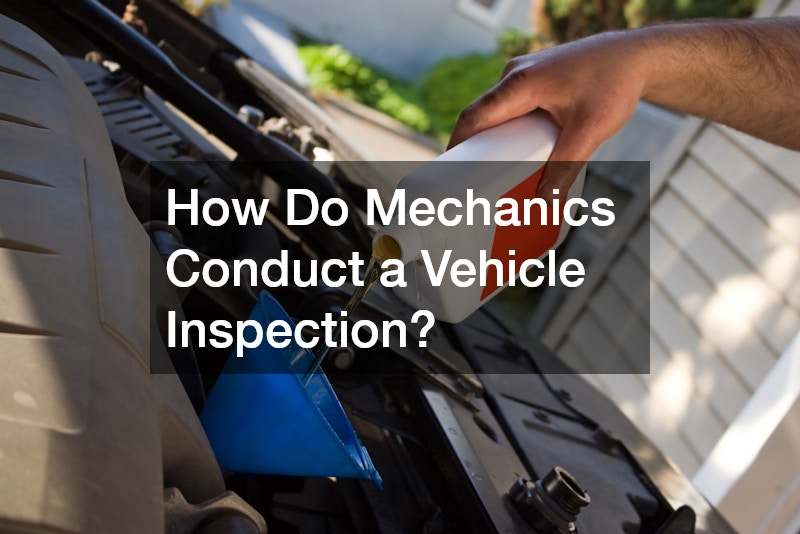
A vehicle inspection is an essential part of vehicle maintenance, ensuring that cars and trucks remain safe, efficient, and roadworthy. Whether required by law, as in the case of annual or biennial inspections in some states, or simply for preventative maintenance, a thorough inspection can catch problems before they escalate into more costly or dangerous issues.
Mechanics, the skilled professionals who perform these inspections, follow a detailed, systematic process to evaluate a vehicle’s various components. But how exactly do mechanics conduct a vehicle inspection? Here’s a closer look at the steps and procedures they follow.
Step 1: Initial Assessment and Documentation
The first part of any vehicle inspection is an initial assessment. When you bring your vehicle to a shop or mechanic for inspection, the mechanic will likely ask you about the car’s recent performance. For example, they might inquire if you’ve noticed any strange sounds, vibrations, or issues with how the vehicle drives. This helps the mechanic understand any immediate concerns or areas to focus on during the inspection.
Once the assessment begins, the mechanic will check the vehicle’s documentation, including its registration and proof of insurance, to verify that the vehicle is up-to-date with legal requirements. In some regions, a vehicle inspection may only be required if the vehicle is a certain age or has passed a particular mileage threshold.
Step 2: Exterior Checks
Once the documentation is sorted, the mechanic typically moves on to the vehicle’s exterior, inspecting key components that affect safety, visibility, and overall condition.
-
Tires and Wheels: The mechanic will check the condition of the tires, ensuring they have sufficient tread depth for safe traction. They’ll also inspect the sidewalls for cracks, bulges, or punctures, and evaluate the overall tire pressure. Improperly inflated or worn-out tires can significantly impact a vehicle’s handling and fuel efficiency.
-
Lights: All exterior lights, including headlights, tail lights, brake lights, turn signals, and fog lights, will be inspected for functionality. Faulty lights can not only compromise your safety but may also lead to fines during a formal inspection.
-
Wipers and Windshield: The mechanic will check the windshield wipers to ensure they are functioning properly and the blades are in good condition. They will also inspect the windshield for cracks or chips that could impair visibility.
-
Suspension and Alignment: The mechanic will check the suspension components, such as shock absorbers, struts, and springs, to see if they show signs of wear. Poor suspension or alignment can affect the vehicle’s handling, making it unsafe to drive.
Step 3: Under the Hood
After assessing the exterior, the mechanic will often raise the hood to inspect the vehicle’s engine and related components. This is a critical part of any vehicle inspection, as it allows the mechanic to evaluate the engine’s performance and its major systems.
-
Engine and Transmission: Mechanics will look for signs of leaks around the engine and transmission, check for the proper level and condition of oil, and ensure that all belts and hoses are intact and properly tensioned. They may also inspect the transmission fluid, as low or dirty fluid can cause transmission problems.
-
Battery and Electrical System: The battery will be tested for charge and any corrosion around the terminals. The alternator will also be checked to make sure it’s properly charging the battery. Electrical connections are essential for many systems in a modern vehicle, so any issues here need to be addressed promptly.
-
Fluid Levels: Mechanics will check essential fluids, including brake fluid, coolant, power steering fluid, and windshield washer fluid. Each of these fluids plays a crucial role in the vehicle’s safety and performance. Low levels or leaks can lead to overheating, brake failure, or steering issues.
Step 4: Brake System Inspection
The brake system is one of the most critical safety components in any vehicle, and mechanics pay special attention to it during a vehicle inspection. The mechanic will check the brake pads and rotors for wear. If the brake pads are too thin, they can compromise stopping ability, so it’s important that they are replaced on time. They may also check the brake fluid for proper levels and ensure that the hydraulic system is functioning correctly. Any issues with the brake system must be addressed immediately, as they can be life-threatening.
Step 5: Exhaust System Check
A thorough inspection of the exhaust system is important to ensure that emissions are controlled and that harmful gases are properly channeled away from the vehicle. The mechanic will look for any leaks, rust, or damage in the exhaust pipes, muffler, and catalytic converter. They will also check the oxygen sensors, which monitor the air-to-fuel ratio in the engine to optimize performance and reduce emissions.
Step 6: Steering and Suspension System Evaluation
The steering and suspension systems are vital for vehicle handling and stability. The mechanic will evaluate the steering system by checking for any excessive play in the steering wheel or unusual noises when turning. They will also inspect the suspension components, including shock absorbers, struts, and bushings. These parts absorb the impact of the road and ensure that the vehicle handles safely.
Conclusion
Vehicle inspections are a vital part of vehicle maintenance and safety. Mechanics follow a comprehensive process that covers the exterior, engine, suspension, brakes, exhaust system, and more. By conducting these thorough checks, they help ensure that your car is roadworthy and that any potential problems are caught early, preventing costly repairs or dangerous situations down the road. Whether it’s a routine inspection or one prompted by an issue, this detailed process is designed to keep both the driver and passengers safe.
.

